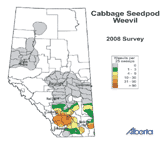| |
2009 Cabbage Seedpod Weevil Forecast | |
| |
|
|
| |
|
|
| |
| Cabbage seedpod weevil was first found infesting canola in southern Alberta in 1995, since then, the weevil has spread to central Alberta and southwestern Saskatchewan. The distribution and abundance of the cabbage seedpod weevil have been monitored yearly in western Canada since 1997. Predictive models based largely on climate data indicate that this pest will eventually disperse to all regions of canola production in western Canada, including the Peace River region. |

Click for a larger map |
 |  |
The 2008 survey indicated a reduced population of cabbage seedpod weevil in southern Alberta. There has also been no significant expansion of the cabbage seedpod weevil range in Alberta. The 2008 survey covered all the canola growing areas of Alberta but the cabbage seedpod weevil is still only found in the southern areas. Many producers, however, still were required to take management action to prevent crop damage and losses. While this is not a true forecast, experience has shown us that the numbers of weevils found at most sites south of Highway 1 have the potential to result in economically damaging populations in the next growing season. This lower population may, however, experience a resurgence in 2009 due to favorable conditions for larval and pupae stages in the late summer of 2008. Experience has also shown us that cooler temperatures and rainfall in August favors the development of the new generation of weevils. Producers need to check their 2009 canola crops as they come into flower. The earliest flowering canola crops tend to have the highest risk from cabbage seedpod weevil and should be monitored more closely.
Because the adult is the overwintering stage of the cabbage seedpod weevil, the risk of infestation is further indicated by the adult population of the preceding fall. High numbers of weevil adults in fall will likely mean significant infestation levels in the following spring. This map does not adjust for the emergence of the new generation in the fall or overwintering conditions.
The cabbage seedpod weevil takes roughly eight weeks to develop from egg to adult. Development time will vary somewhat depending on weather conditions, especially temperature. There is one generation per year. Follow this link for further information about the life cycle.
Crop damage from cabbage seedpod weevil can occur from bud-blasting (potentially reducing yield in dry years), larval feeding within developing pods (larva consumes about five seeds) premature shattering of damaged pods and new generation adults that emerge in the fall feeding on nearly developed seeds. The larval feeding alone can result in yield losses of 15 to 20 percent of each pod infested.
Because the adult is the overwintering stage of the cabbage seedpod weevil, the risk of infestation is further indicated by the adult population of the preceding fall. High numbers of weevil adults in fall will likely mean significant infestation levels in the following spring, although a severely cold winter with little snow cover could reduce the survival of overwintering adults.
Cabbage seedpod weevil adult abundance is best monitored by using sweep net samples. Sampling should begin when the crop first enters the bud stage and continue through the flowering period. Select ten locations within each field, and at each location count the number of weevils from ten 180 degree sweeps. Sampling locations should include both the perimeter and interior of the field to obtain an accurate estimate of weevil numbers throughout the field.
This monitoring procedure will also give an indication of the number of lygus bugs present and may serve as an early warning for lygus damage, provided that the same fields are monitored into the early pod stage.
The 2007 cabbage seedpod weevil survey was carried out by Alberta Agriculture and Food with support from the Applied Research Associations, Vitera and various private consultants.
For more information on cabbage seedpod weevils and their management contact the Ag-Info Centre at 310-FARM (3276).
Follow this link to print a page size map.
2009 forecast based on 2008 survey data
FAQ |
|
| |
|
|
| |
Other Documents in the Series |
|
| |
2014 Cabbage Seedpod Weevil Forecast
2012 Cabbage Seedpod Weevil Forecast
2010 Cabbage Seedpod Weevil Forecast
2009 Cabbage Seedpod Weevil Forecast - Current Document
2008 Cabbage Seedpod Weevil Forecast
|
|
| |
|
|
| |
For more information about the content of this document, contact Scott Meers.
This document is maintained by Shelley Barkley.
This information published to the web on January 26, 2009.
Last Reviewed/Revised on February 22, 2011.
|
|